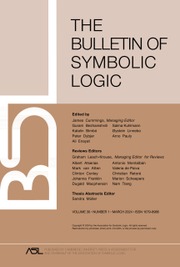Article contents
Weak Distributivity, A Problem of Von Neumann and the Mystery of Measurability
Published online by Cambridge University Press: 15 January 2014
Extract
This article investigates the weak distributivity of Boolean σ-algebras satisfying the countable chain condition. It addresses primarily the question when such algebras carry a σ-additive measure. We use as a starting point the problem of John von Neumann stated in 1937 in the Scottish Book. He asked if the countable chain condition and weak distributivity are sufficient for the existence of such a measure.
Subsequent research has shown that the problem has two aspects: one set theoretic and one combinatorial. Recent results provide a complete solution of both the set theoretic and the combinatorial problems. We shall survey the history of von Neumann's Problem and outline the solution of the set theoretic problem. The technique that we describe owes much to the early work of Dorothy Maharam to whom we dedicate this article.
§1. Complete Boolean algebras and weak distributivity. A Boolean algebra is a set B with Boolean operations a ˅ b (join), a ˄ b (meet) and −a (complement), partial ordering a ≤ b defined by a ˄ b = a and the smallest and greatest element, 0 and 1. By Stone's Representation Theorem, every Boolean algebra is isomorphic to an algebra of subsets of some nonempty set S, under operations a ∪ b, a ∩ b, S − a, ordered by inclusion, with 0 = ∅ and 1 = S.
Complete Boolean algebras and weak distributivity.A Boolean algebra is a set B with Boolean operations a ˅ b (join), a ˄ b (meet) and -a (complement), partial ordering a ≤ b defined by a ˄ b = a and the smallest and greatest element. 0 and 1. By Stone's Representation Theorem, every Boolean algebra is isomorphic to an algebra of subsets of some nonempty set S, under operations a ∪ b, a ∩ b, S -a, ordered by inclusion, with 0 = ϕ and 1 = S.
Information
- Type
- Articles
- Information
- Copyright
- Copyright © Association for Symbolic Logic 2007
References
REFERENCES
- 12
- Cited by

